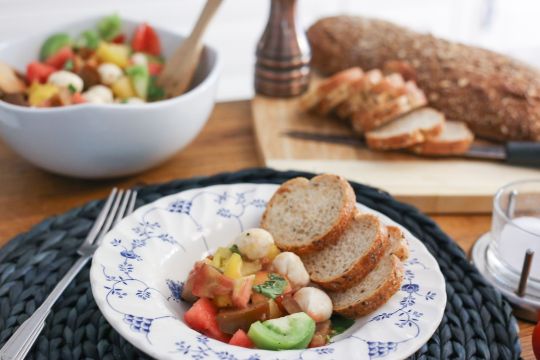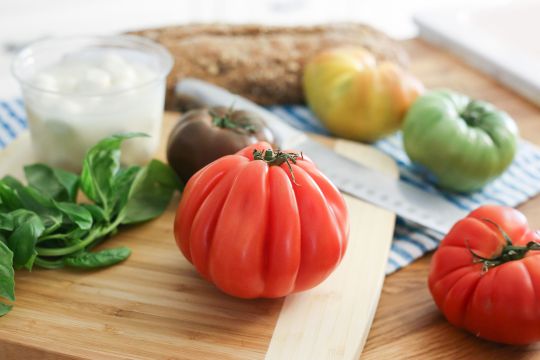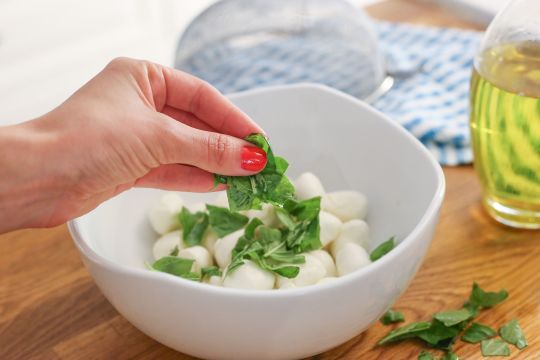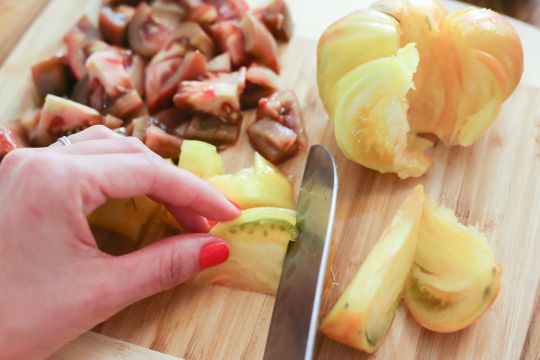

A fresh, juicy, perfectly ripe tomato is one of the finest treats summer can offer. Many of the best are heirloom varieties, cherished over the generations for their flavor.
These old favorites can revolutionize any tomato-based dish. Sometimes, the hardest part is deciding which recipes deserve their bright, fresh flavors. A Caprese salad is one of the simplest and best. This version puts your heirloom tomatoes front and center.
Start to Finish: 10 minutes • Servings: 4 to 6 • Difficulty Level: Beginner

Ingredients
- 1 pound low-fat bocconcini, bite-sized
- 2 to 3 tablespoons extra-virgin olive oil
- 6 leaves fresh basil
- 3 to 6 heirloom tomatoes
- Multi-grain baguette or ciabatta

Directions
- Drain the bocconcini. Ideally, they should be the size of a grape tomato or smaller, or cut up larger bocconcini to that size.
- Combine the bocconcini and olive oil in a serving bowl. Tear the basil into small pieces and toss it with the bocconcini.
- Core and chop the tomatoes coarsely, to about the same size as the bocconcini.
- Add the tomatoes and their juices to the bowl and toss until they’re coated with oil. The basil pieces and bocconcini should be evenly distributed throughout.
- Serve the salad with slices of multi-grain baguette or ciabatta to soak up the flavorful juices and oil.

Some Quick Notes
Heirloom tomatoes come in a startling variety of colors. The more you use, the more striking your salad will be. Try mixing red, yellow, green and purple varieties for maximum impact.
The longer the salad rests, the juicier it becomes. For a gloriously messy version, make it up to an hour ahead of time. Add the basil just before serving; otherwise it will mask the tomatoes’ subtle sweetness.
Tomatoes vary in size, so use as many as you need. You should have 2 ½ to 3 cups of chopped tomato when you’re finished.
Bocconcini are small balls of fresh-made mozzarella, with a clean, milky taste. You’ll find it in the refrigerated section of most supermarkets, and in Italian specialty shops. If you’re unable to find bocconcini, use good-quality mozzarella cut to the same size as your tomatoes.

Not Just Flavor
It’s taste that “sells” heirloom tomatoes, but nutrition counts too. The National Nutrient Database doesn’t single out heirloom tomatoes specifically, but its listings for red, yellow and orange tomatoes provide a useful benchmark.
They’re rich in potassium, vitamin C and folate. Red and orange tomatoes are good sources of vitamin A. Red tomatoes also provide lots of lycopene, an antioxidant that might reduce the risk of some cancers. Furthermore, some research suggests that heirloom plants might offer more nutrition than modern hybrids.
What’s your reason for eating heirloom tomatoes? Do you choose them for health reasons or nutrition?
By: Fred Decker, Demand Media
Fred Decker is a trained chef and certified food-safety trainer. Decker wrote for the Saint John, New Brunswick Telegraph-Journal, and has been published in Canada’s Hospitality and Foodservice magazine. He’s held positions selling computers, insurance and mutual funds, and was educated at Memorial University of Newfoundland and the Northern Alberta Institute of Technology.

